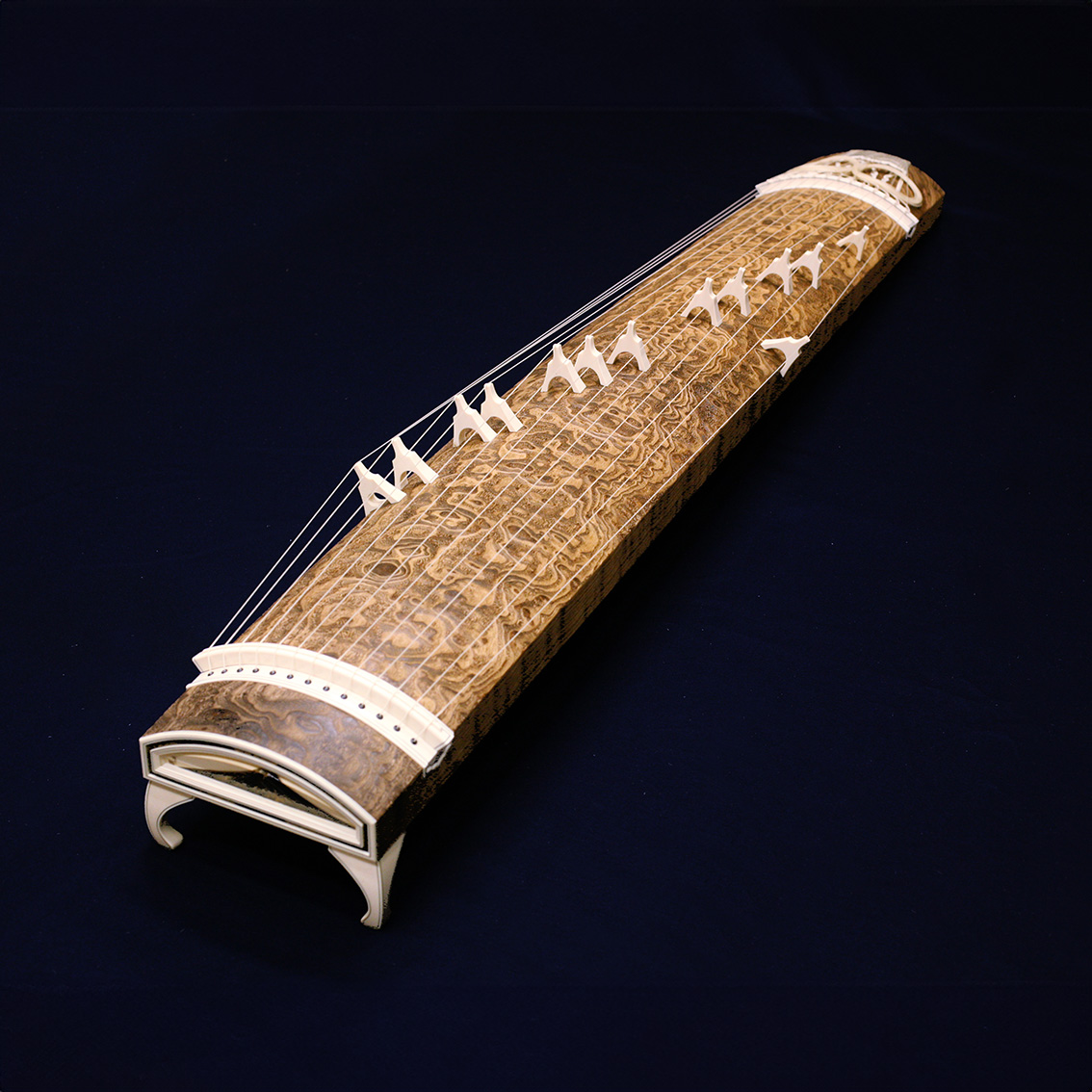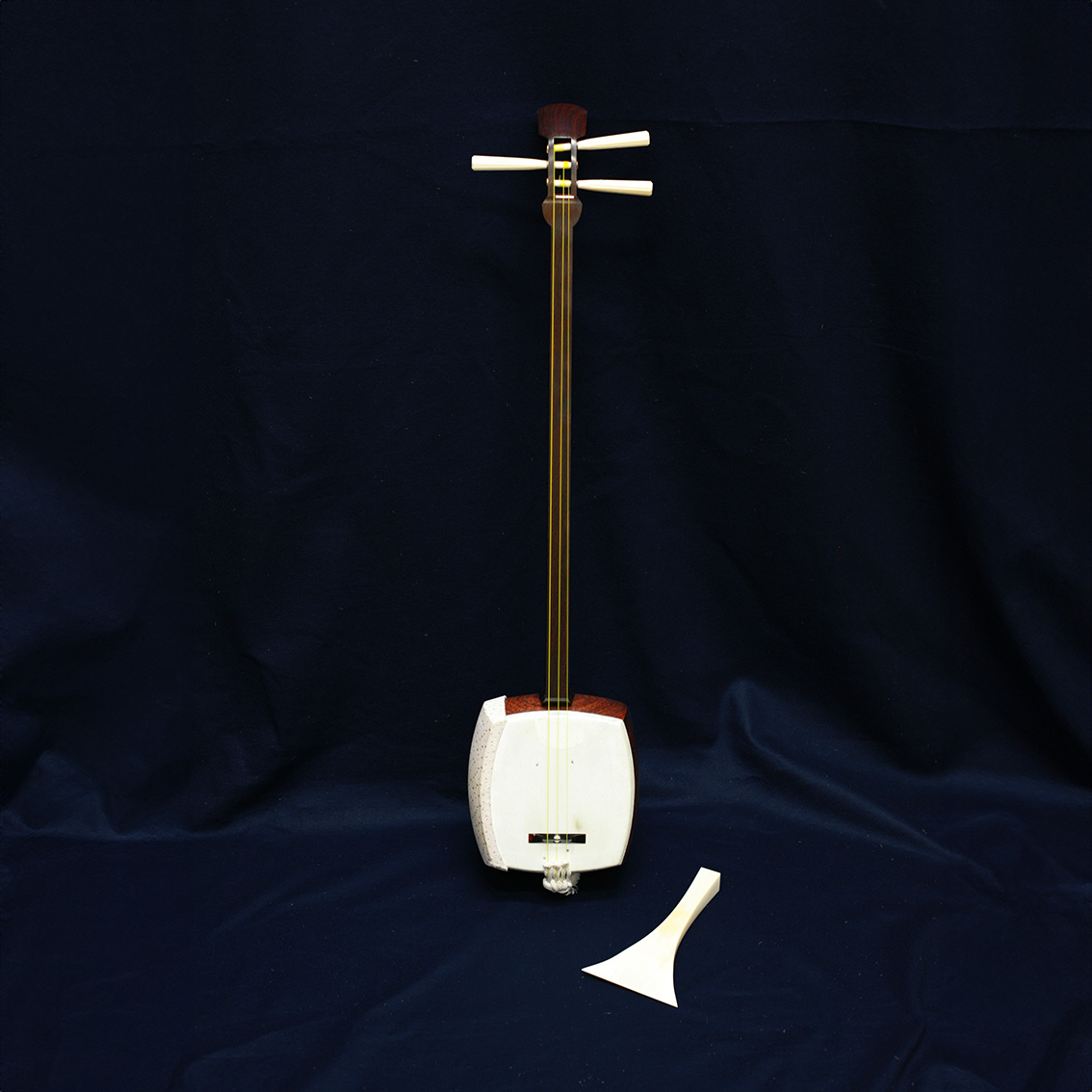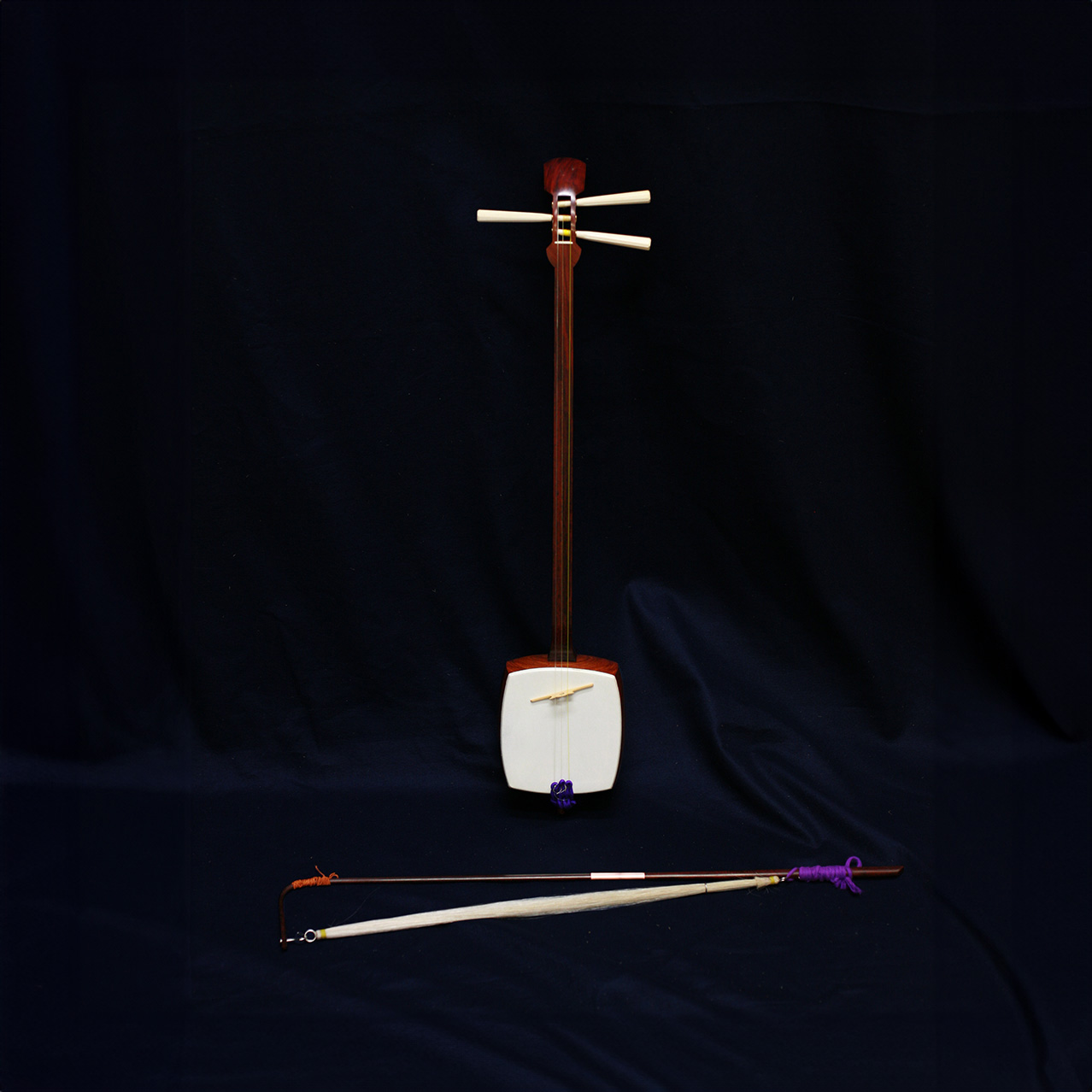
箏
一般的に「こと」と呼ぶのは、この弦楽器です。奈良時代に雅楽の楽器として中国から日本に伝来しました。通常十三弦で、柱というものを立てて調弦します。そして、右手親指、人差し指、中指に爪をはめて演奏します。従って、通常七弦で、柱を立てないかわりに左手でポジションを押さえて素手で弦を弾く「琴」とは、まったく別の楽器なのです。
また、低音域用として考案された十七弦の箏もあります。これは、「春の海」の作曲者として著名な宮城道雄が考案した楽器です。十三弦の箏よりも楽器本体の全長、幅、厚みなどがひとまわり大きくつくられているだけでなく、弦も太くなっています。
箏はもともと、貴族の必修教養楽器として愛用されていましたが、鎌倉時代以降、寺院歌謡の楽器として伝承され、そこから筑紫箏というジャンルが成立しました。さらにその筑紫箏を母体として、江戸時代初期の八橋検校以後、現在の箏の原点となる近世箏曲が成立し、日本を代表する楽器として広く知られています。
The Koto (So-)
This is the Japanese stringed instrument called "Koto". It was introduced into Japan from China as an instrument of the Gagaku (the court music) in the Nara Period. Usually, this instrument is the 13 stringed type, and has standing ji (kotoji) which are the small bridges under each string that the player can slide to adjust the tuning. To play the koto, wear three artificial nails on the right hand thumb, forefinger and middle finger. Therefore, it is really another instrument with "Kin" which has 7 strings and no kotoji, plays the string by empty handed, hold a position with the left hand.
Then there is the koto of 17 strings devised for the low range. This is the instrument devised by Miyagi Michio who was the most famous musician as a composing person ("composer") of "Haru-no-umi". The instrument's parts, for example, the body's entire length, the width, the thickness, the thickness of the string and so on are bigger than koto of 13 strings.
Koto was used to play as a compulsory culture instrument of nobles. After the Kamakura Period, it was transmitted as an accompaniment tool of a song for the temple, and the genre of tsukushi-goto (the older tradition of koto music) was born from there. Besides, that tsukushi-goto as a matrix, the modern koto music which became the origin of koto established by Yatsuhashi Kengyo in the early stages of the Edo Period. That is well-known as an instrument which represents Japan now.

三味線
日本を代表する弦楽器の一つですが、意外にその歴史の浅いのが三味線です。中国の「三弦」が琉球に渡って「三線」となり、さらにそれが本土へともたらされたのが十六世紀半ばであったと伝えられています。
本土でこの楽器を最初に手にしたのは、琵琶法師だと言われています。彼らは、撥を用いてこの弦楽器を演奏したため、蛇皮のままではすぐに破れてしまったようです。またそれを修復する蛇皮も、本土では入手が困難なため、猫皮や犬皮を張った三弦楽器が生まれたと言われています。
三味線の大きな特徴の一つは、一番太い一の糸を上駒から外し、サワリという効果が工夫されていることです。この効果によって、一の糸はビーンという独特の音色を出します。音程によっては、二の糸や三の糸を弾いたときにも、一の糸に共鳴してサワリの効果が得られます。
三味線は、演奏される音楽の種類によって、胴や棹の大きさや太さ、皮の厚さ、駒や撥の大きさや重さ、糸の太さなどが、それぞれ異なります。大まかには、棹の太さによって太棹・中棹・細棹の3グループに分けられます。
The Shamisen
The shamisen (three stringed instrument) is one of the stringed instruments represents Japan, surprisingly, its history is comparatively short. It is said that Chinese three stringed instruments "San xian" introduced to the Ryu-kyu- Islands, and comes to be called "Sanshin", then, sanshin was introduced to Japan in the middle of 16th century.
In Japan the shamisen was first played by biwa players. It seems that instrument's body (covered by a snake skin) was tore by using the bachi (plectrum for playing biwa). In addition, it was very difficult to get the snake skin for repair it in Japan. Therefore, shamisen's body is covered with the cat skin or the dog skin.
One of the great characteristics of the shamisen put out the thickest string called "Ichi-no-ito" from the upper bridge, and it is that the effect of sawari (the effective noise) is devised. The Ichi-no-ito takes out the appealing tone by the effect of sawari. By the pitch, when the midlle string "Ni-no-ito" and the slimmest string "San-no-ito" is played, it is resonant with the Ichi-no-ito, and it can get the effect of sawari.
The shamisen is different from kind by played music respectively varies the size of the trunk, the thickness of the pole, the thickness of the skin, the weight of the bridge and the stick, the thickness of the strings, and so on. Broadly speaking, it is divided into three groups; the thickest pole called Futozao, the middle pole called Chu-zao, and slimmest pole called Hosozao.

胡弓(大胡弓)
日本で唯一、弓で弦をこすって演奏する楽器です。形はほぼ三味線と同じで、弦数も三弦が通常です。弓は馬の尾の毛を束ねたものですが、その毛はピンと張らず、演奏する際に指で張力を加えます。三味線同様、胡弓の棹は胴の枠を串刺しにするようにして先が突き出ており、その部分を中子先と言いますが、その長さは三味線のものに比べるとかなり長いのが通常です。そして、演奏するときに、中子先を両膝の間に挟むような格好で楽器を構え、中子先を支点に、楽器そのものの向きを変えながら演奏するのが特徴です。
宮城道雄は、胡弓の音量を増加しようとして、この胡弓を少し大型にしました。それが、大胡弓と呼ばれるものです。大胡弓は、上記の胡弓と三味線との中間ぐらいの大きさですが、通常の胡弓のように中子先は突き出ておらず、見た目はいっそう三味線に近いと言えるでしょう。
なお、日本の胡弓の起源については、はっきりしたことはわかりませんが、江戸時代初期には存在したことが確認されています。
The Kokyu (Dai-kokyu)
This is the only Japanese instrument to play with a bow. Kokyu's shape is about the same as the shamisen, and it usually has 3 strings. That bow is made of the bundled hair of the tail of the horse. The hair of bow doesn't tighten up straight, adjusts tension by the finger when it plays. The Kokyu pierces its body with the pole as well as the shamisen, and the pole's top sticks out; that part is called "nakagosaki". The length of Kokyu's nakagosaki is usually much longer than shamisen's one. Playing the Kokyu, set up an instrument to put nakagosaki between knees, and change the direction of the instrument itself on the fulcrum of nakagosaki.
MIYAGI Michio made a large size Kokyu to increase the volume of it. That is called "Dai-kokyu". Dai-kokyu's size is about the middle with prevailing Kokyu and shamisen. It is different from usual kokyu that nakagosaki of Dai-kokyu doesn't stick out. Therefore, its appearance is even closer to the shamisen.
Though the origin of Japanese Kokyu is not clear, it is confirmed that it existed in the early stages of the Edo Period.
text : 井口はる菜
Utanoichi Okuda © All Rights Reserved.
![]()
